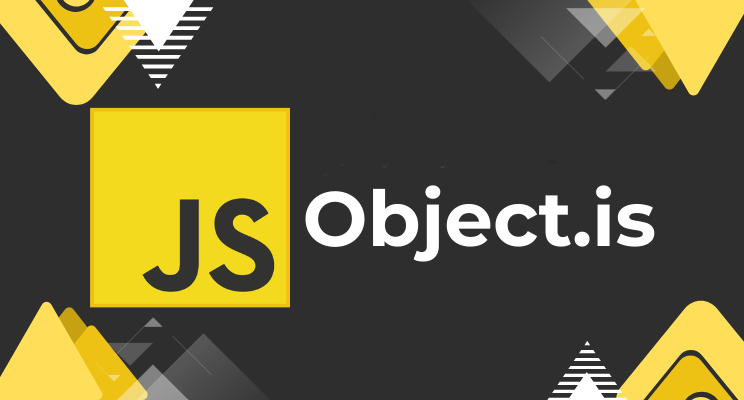🔍 Understanding Object.is() in JavaScript: A Comprehensive Guide 🎯
 Yasin Sarkar
Yasin Sarkar
In JavaScript, comparing values is an everyday task. We often use operators like == (loose equality) or === (strict equality) for comparison. However, JavaScript also provides another method called Object.is(), which adds unique behavior to equality checks. In this article, we’ll explore how Object.is() works, how it differs from other operators, and when you should use it. 🚀
📝 Table of Contents:
✨ What is
Object.is()?🤔 Differences Between
Object.is(),==, and===💡 When to Use
Object.is()🛠️ Common Use Cases
🎯 Conclusion
1. ✨ What is Object.is()?
Object.is() is a method in JavaScript used to determine whether two values are the same. It’s a simple yet powerful method that takes two arguments:
javascriptCopy codeObject.is(value1, value2);
If the two values are exactly the same, it returns true; otherwise, it returns false. ✅
Example:
javascriptCopy codeObject.is(5, 5); // true
Object.is('hello', 'hello'); // true
Object.is({}, {}); // false (different references)
At first glance, this looks similar to ===, but as we’ll see, there are important differences! 👀
2. 🤔 Differences Between Object.is(), ==, and ===
Even though both Object.is() and === check for strict equality, they behave differently in specific cases.
2.1 Key Differences from ===:
NaN Comparison: In JavaScript,
NaN === NaNevaluates tofalse, which can be confusing. However,Object.is()correctly treatsNaNas equal to itself. 🔄javascriptCopy codeNaN === NaN; // false ❌ Object.is(NaN, NaN); // true ✅Positive and Negative Zero: JavaScript considers
0 === -0astrue, butObject.is()distinguishes between positive and negative zero.javascriptCopy code0 === -0; // true ❌ Object.is(0, -0); // false ✅
These cases make Object.is() more accurate for specific comparisons than ===. 🔥
2.2 Differences from ==:
The == operator performs type coercion, meaning it converts values to the same type before comparing them. This can lead to unexpected results:
javascriptCopy code1 == '1'; // true ❌ (because of type coercion)
Object.is(1, '1'); // false ✅ (no type coercion)
Object.is() doesn’t perform type coercion, so it only returns true when values are exactly the same. 🔒
3. 💡 When to Use Object.is()
Now that we know the differences, let’s see where Object.is() shines! ✨
3.1 Detecting NaN:
If you need to check for NaN, Object.is() is the way to go because === won’t catch it!
javascriptCopy codeconst result = NaN;
if (Object.is(result, NaN)) {
console.log('The result is NaN');
}
3.2 Handling Positive and Negative Zero:
In calculations or measurements where 0 and -0 have different meanings, Object.is() can distinguish between them. ⚖️
javascriptCopy codeObject.is(0, -0); // false ✅
3.3 Accurate Object Comparisons:
For advanced cases where precision matters (like when working with custom objects or floating-point math), Object.is() helps avoid the pitfalls of ===.
4. 🛠️ Common Use Cases
4.1 Avoiding Bugs in Complex Apps 🐞:
In large applications dealing with various data types, using Object.is() prevents unexpected behavior, especially around NaN, 0, and -0.
4.2 Ensuring Cross-Environment Compatibility 🌐:
Some libraries and polyfills use Object.is() to ensure equality checks behave consistently across different environments.
4.3 React's Use of Object.is() ⚛️:
In React, the useState hook internally uses Object.is() to check if state values have changed, ensuring edge cases like NaN or -0 are handled properly.
javascriptCopy codeconst [state, setState] = useState(0);
setState(-0); // React uses Object.is() to compare values
5. 🎯 Conclusion
Object.is() may not be as widely known as == or ===, but it offers more accurate value comparison in certain cases. It excels when dealing with tricky edge cases like NaN and distinguishing between 0 and -0. 💪
Whenever you need precise comparisons, especially in complex applications or special data handling, consider using Object.is() to avoid subtle bugs. The next time === or == doesn’t behave as expected, remember that Object.is() has your back! 👏
💬 What are your thoughts on Object.is()? Let’s discuss in the comments!
Subscribe to my newsletter
Read articles from Yasin Sarkar directly inside your inbox. Subscribe to the newsletter, and don't miss out.
Written by

Yasin Sarkar
Yasin Sarkar
Front-End Developer. I create dynamic web applications using HTML, Tailwind CSS, JavaScript, React, and Next.js. I share my knowledge on social media to help others enhance their tech skills. An Open Source Enthusiast and Writer.